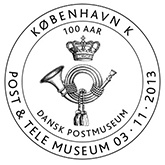History of the Museum

The Danish Postal Museum
Shortly after Jens Wilken Mørch, who at a later stage was appointed Head Postmaster in Copenhagen, in 1856 took up his duties in the Danish Post office, he began to collect the objects which were to form the nucleus of the museums collection.
In 1907, he surrendered his collection to the postal authorities, and it was placed in the Post Yard in Købmagergade. However, as the collection was cramped for space, the public was not admitted.
When the Central Post Office building in Tietgensgade was inaugurated in 1912, three rooms covering a total space of 310 m2 were handed over to the museum which at the same time took over the stamp collection of the General Directorate. On 3rd November 1913, the museum was opened to the public.
In 1919, the museum had to close to make room for the newly established Postal Giro Office which left the building five years later. The museum got back the premises and was even granted an extra room so a total of 405 m2 was now at its disposal. The museum re-opened in 1926.

The Danish Post and Telegraph Museum
When the Post Office merged with the Telegraph Office in 1927, it was decided to extend the museum with a collection of items concerned with telecommunications which Hans Haller, assistant engineer, had founded as early as around 1908. 141 m2 of floorage was available for the purpose.
The new department was inaugurated on 21st May 1931, and the named of the museum was changed to the Danish Post & Telegraph Museum.
In July 1940, the German occupying forces made a "blitzkrieg" against the museum which was given two days to clear the premises housing the postal exhibits as these were to serve as office for the censorship of letters. Therefore, the telecommunications department was turned into a densely packed "warehouse".
It was not possible to re-open the exhibition until 1945, but as the collection of exhibits had continued during the war, the lack of space was more perceptible than ever. This did not, however, give rise to any further extension of the space; on the contrary, soon the museum had to sacrifice 50 m2 on the altar of administration.
In 1954, the General Directorate was reluctantly compelled to ask the museum to leave the Central Post Office building. As luck would have it, the City Museum of Copenhagen was moving the the premises of the previous royal shooting gallery in 59 Vesterbrogade 59 and did not need the side wing.
The Danish Post and Telegraph Museum moved in and was able to extend the floorage to 650 m2. The new premises were inaugurated on 15th September 1956.

In the course of time, both museums needed more room and the Post & Telegraph Museum had to look for another domicile. Once again, the museum was in luck; The telecommunications service was going to move from the building in 7-9, Valkendorfsgade which P&T had bought in 1939. Now the museum had the opportunity to take over the building covering a gross floorage of about 1,475 m2 - and did not miss it!
In 1728, the street of Valkendorfsgade, the name of which at that time was Store Hellig Geist Stæde, was in ruins as the result of a fire. The central part of the present museum building was rebuilt in 1730.
In 1771, a printer named J.R. Thiele acquired most of the building and two years later he owned all of it. This is of historical interest to the Post Office as this is where Danish stamps were printed from 1852 to 1933 when the postal authorities took over the production.
The annexes were probably built around 1740. The building nearest Købmagergade was torn down and rebuilt in its present state in 1870, and the other annex whent through a similar change in 1875. In both cases, the printeers Just and Andreas Thiele were the builders.
The Danish Post and Telegraph Museum was housed in 7-9 Valkendorfsgade 7-9 until the opening of Post & Tele Museum in 37, Købmagergade in October 1998. The museum in its entirety is today consisting of exhibition galleries of about 3,000 m2.
